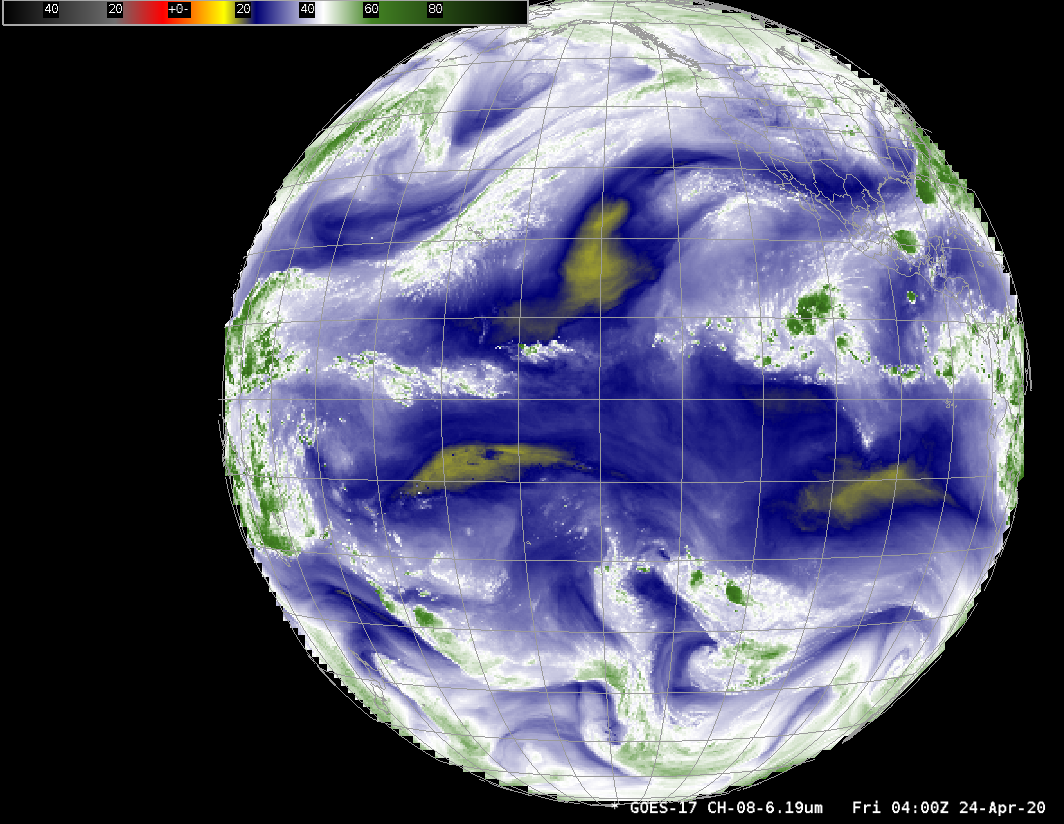GOES-17 Scanning designed to reduce heating-caused data outages
NOAA/NESDIS has modified the GOES-17 Mode 6 scanning schedule during times of increased data-outages related to the faulty Loop Heat Pipe (LHP) mechanism (Blog Post 1, 2, 3 on that subject; see also here) on GOES-17. (The OSPO Notification is here). Between 0600 and 1200 UTC, Full Disk scans are imaged every 15 minutes, rather than every 10; the two flexible mesoscale sectors (including the one with a default location over Alaska) are scanned every 2 minutes, rather than every minute; the GOES-17 ‘CONUS’ domain, also known as the PACUS domain, typically scanned every 5 minutes, is not scanned at all. These modifications will be in place in 2020 from 9 April through 1 May, from 12 August through 1 September and from 14 October through 31 October. Dates for 2021 (and beyond) have not yet been determined. The ‘time-time’ chart for this modified scanning is shown below (figure source).

‘Time-Time’ chart for GOES-17 Scanning during Mode 3 Cooling operations. Cyan regions denote no ABI scanning activity, green regions are Meoscale sector scans, pink denotes the full disk scan. Other colors show navigation and calibration times. Note the lack of a 5-minute PACUS scan (Click to enlarge)
This change in scanning strategy mitigates heating-caused imagery losses because it reduces the amount thermal energy absorbed by the ABI when it is pointed towards a warm source (that is, Earth) instead of cold outer space. By reducing the scanning periods, OSPO reduced (but did not eliminate) the span of time during which time data from many of the infrared channels of the ABI are unusable because of saturated sensors.
Note in the animation above how the time-step changes at 0600 UTC to every 15 minutes, and then changes back to every 10 minutes at 1200 UTC. A slower animation from 0530 – 0630 UTC (link) shows that increment change more clearly. Because the so-called CONUS scan does not happen, GOES-17 CONUS scan imagery is not available during this time window; of course, data are available in the CONUS region via the every-15-minute Full Disk scans.
The image below, courtesy Mat Gunshor, CIMSS, (derived from this website) shows how this Mode 3 Cooling Operations reduces the window when data are unavailable. The time span when data are unusable (highlighted by the green double-headed arrows) is shorter in 2020 as a result of this new scanning strategy. Also, the peak Focal Plane Module (FPM) Temperature is reduced, which may have implications for the long-term health of the satellite.

Comparisons between GOES-16 and GOES-17 Low-Level water vapor infrared imagery (Band 10, 7.34 µm). Julian day 104 from 2019 (left) and 2020 (right). GOES-16 and -17 Full-Disk imagery at the end of the time series as shown. Time series plots (bottom) show the Focal Plane Module (FPM) temperature (black) and the GOES-17 – GOES-16 brightness temperature difference (blue) for a region centered on the Equator equidistant between the two satellite sub-points.


